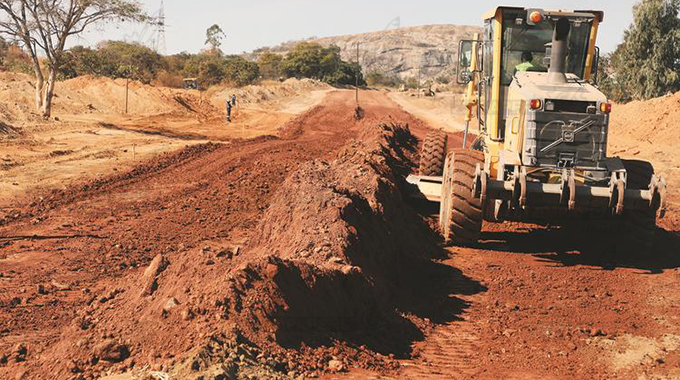Zim goes a gear up in drive to boost tourism

Isdore Guvamombe Assistant Editor
The world over, tourism is regarded a low hanging fruit that brings more attention to the entire orchard (country), as people search for more and more juicy fruits.
Zimbabwe is endowed with an array of tourism tapestries — from man-made up to those sired by natural phenomena — all these have the potential to attract investors who come first as tourists and then later as investors.
It is fact, not fiction, that many investors visit places as tourists first, fall in love with the place and what it offers and return as investors.
From the world famed Victoria Falls to the craggy magnificence of the Eastern Highlands, the rolling moorlands, high mountain heath, pristine wildlife, spooky caves, gothic ancient stone-without-mortar cities and a welcoming people, among others, Zimbabwe is a tourist attraction with something for everyone.
Zimbabwe and Britain share a lot of history from the days of colonialism to independence and promoting tourism development and investment between the two countries should not be difficult given that Zimbabwe has decided to rejoin the Commonwealth and has done everything in its powers to do so assiduously.
After the long hiatus in which the country was isolated through travel warnings and travels vetoes from the United States of America and the European Union in the old dispensation, Zimbabwe under the new dispensation has set its eyes on international re-engagement, and tourism had been identified as one of the major pillars of the country’s economic turnaround programme.
Tourism has further been recognised as a vital cog in the country’s Transitional Stabilisation Programme (TSP) and the attainment of Vision 2030.
Again, tourism has been identified as critical to Zimbabwe’s rejoining the Commonwealth, an organisation of former colonies of Great Britain.
It is in line with this new trajectory that Zimbabwe is taking its tourism tapestries to the United Kingdom, as it moves for an all-inclusive political and economic re-engagement.
Environment, Tourism and Hospitality Industry Minister Prisca Mupfumira and Zimbabwe Tourism Authority acting chief executive Rita Likukuma are in the UK to market Zimbabwe’s tourism tapestries as part of the country’s broader re-engagement.
The two are known for their negotiating skills, vision and resilience. They have planned roadshows and workshops throughout the UK.
The United Kingdom National Statistics Office (NSO) 2018 Report stated that there were 123 000 adult Zimbabweans in the United Kingdom who include 53 000 men and 70 000 women.
Among this huge Diaspora community are many equally committed to raise the profile of the country through partnerships or to promote the country to their families, friends and workmates.
Henceforth, this new Diaspora roadshow that will be in collaboration with ZIM-Thrive 2020.
Their visit comes hard on the heels of another top-drawer visit to the UK by Foreign Affairs Minister Sibusiso Moyo last week.
Of interest is that Zimbabwe is marketing its tourism tapestries based on its homegrown assets, the wonderful people and culture, rich history and heritage, the majestic Victoria Falls, the Great Zimbabwe, pristine wildlife and nature, the mystique of the Eastern Highlands, the mythical Kariba and the Mighty Zambezi River.
Critical to note is that President Mnangagwa has declared “Zimbabwe is now open for business” and has persistently, consistently and passionately enunciated this position as he articulates his vision.
Indeed, the tourism economy was closed for business, but the new leadership which ushered in the new political dispensation has done everything in its power to bring back lost glory in tourism.
Also critical is the fact that the Government recognises the tourism industry as one of the key economic sectors with the potential to increasingly contribute to national economic turnaround.
According to World Travel and Tourism Council (WTTC), which is the world body of the private sector, slightly over 300 000 people are employed either directly, indirectly or induced by the tourism sector in Zimbabwe.
That is not a small figure and it could be increased with new investment opportunities in Zimbabwe.
The sector lost out over the past two decades in terms of investment and tourist arrivals, hence the need to promote its growth and development.
It has been made clear that there is a serious investment opportunity in the accommodation sector in Zimbabwe as the country holds slightly more than 12 000 hotel rooms against a growing demand.
It should be noted that Zimbabwe has a less diversified product base and underinvested in terms of accommodation facilities (low- cost through to luxury facilities), convention centres and exhibition parks and entertainment facilities.
The envisaged tourism growth going into 2030 calls for increased tourism investment.
The increased tourism investment opportunities are expected to be unlocked through, among other issues, the following: the National Tourism Master Plan, National Tourism Sector Strategy, Vision 2025: National Tourism Recovery and Growth Strategy, the Victoria Falls Master Plan, the Kariba Master Plan and the Tokwe-Mukosi Master Plan.
This can further be enhanced by the nine Tourism Development Zones (TDZs), namely Beitbridge-Gwanda-Shashe-Limpopo; Masvingo-Great Zimbabwe-Chiredzi-Gonarezhou; Matopos; Kariba-Zambezi Valley; Mudzi, Lake Chivero-Manyame and the Midlands, that have already been designated.
Through Statutory Instrument 50 of 2006, tourism businesses in the designated TDZs are allowed to import capital goods duty free
The TDZs also come with the following tax breaks:
Duty exemption on specified capital goods imported for use in TDZs
Tax on the income of an operator is as follows: First five years of operation — 0 percent, second five years of operation (15 percent), third five years of operation (20 percent) and thereafter normal rates of corporate tax apply.
This is a big investment incentive.
The Government has also come up with the Special Economic Zones Act (Chapter 14:34) that has been coupled by special incentives provided for by SI 59 of 2017 to attract new investments into the Special Economic Zones (SEZ).
In that vein, Government has selected three locations for piloting the SEZ concept — Victoria Falls, Harare and Bulawayo.
The special incentives include rebate of duty on raw materials, intermediate products, equipment and machinery and trinkets that go with SEZ project status.
In terms of investment in conservation, the Government has come up with the Transfroniter Conservation Project.
In that case, Zimbabwe is a signatory to six Trans-Frontier Conservation Areas (TFCAs), which also provide opportunities for, especially in lodges and safari camps.
These TFCAs are Limpopo-Shashe (now Greater Mapungubwe); Kavango-Zambezi (KAZA); Lower Mana Pools; Zimbabwe-Mozambique-Zambia (ZIMOZA); Chimanimani and Greater Limpopo which include Gonarezhou National Park.
Both countries stand to benefit from renewed working together in tourism, development, marketing and investment.









Comments